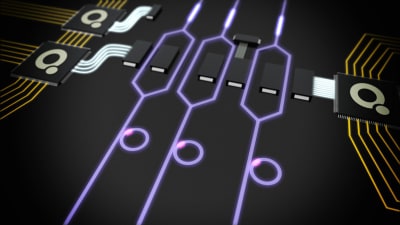
MIT’s Remarkable Advancement in Quantum Computing: Most Robust Light-Matter Coupling Achieved to Date
In a significant advancement for practical quantum computing, researchers at MIT have revealed an unparalleled level of nonlinear light-matter coupling within a quantum framework—what they assert is the most robust ever recorded. This innovation, realized through a cutting-edge superconducting circuit design, greatly enhances the pace of quantum operations and could bring the advent of a fault-tolerant quantum computer within reach.
This study, published in Nature Communications, was spearheaded by Kevin O’Brien, associate professor and leader of the Quantum Coherent Electronics Group at MIT, alongside lead author Yufeng “Bright” Ye, a recent Ph.D. graduate from MIT. Ye noted, “This truly removes one of the major obstacles in quantum computing. It has the potential to hasten how quickly we can achieve the fault-tolerant quantum computing phase and enable real-world applications and benefits from our quantum computers.”
A Breakthrough in Quantum Velocity: The Quarton Coupler
Central to this advancement is a unique device known as the “quarton coupler.” This part facilitates interaction between an artificial atom—responsible for storing quantum information—and a photon—used for transmitting quantum data—with a coupling strength approximately 10 times that of earlier records. In the realm of quantum computing, this coupling strength is vital: the more intense the interaction between light and matter, the quicker quantum gates can execute operations and deliver readouts.
In classical computing, rapid signals lead to faster calculations. However, quantum computing is constrained by the delicacy of quantum bits—or qubits—which exist in intricate superpositions of states and are highly prone to decoherence (the loss of quantum information). Consequently, accelerating operations not only boosts efficiency but also helps maintain qubits’ accuracy and utility for extended periods.
“Our circuit fundamentally transforms the scale of light-matter interaction within the quantum domain,” remarked Ye. By shortening operation time, the system permits more cycles of error correction and productive computation within the brief coherence window, representing a notable enhancement in tackling one of the field’s persistent challenges.
Quantum Operations and Reliability
A traditional quantum system often necessitates external measurements between cycles of error correction, a requirement that hampers computation speed and diminishes fidelity. The innovative architecture conceived by the MIT team bypasses much of this limitation by facilitating real-time measurement and control, made possible by the enhanced coupling.
This improvement could lead to a more efficient realization of fault-tolerant quantum computing—a framework where logical qubits are shielded from errors through multiple physical qubits and intricate correction codes. With swifter processing of these corrections, the system becomes more resilient and dependable.
From Theory to Practice
The quarton coupler is a product of years of foundational research at MIT. Ye joined O’Brien’s lab in 2019 to focus on specialized photon detectors, but his pursuit of deeper physics eventually guided him to create this transformative coupler.
“The goal was to push the limits of how strong we could make this coupling while sustaining control and coherence,” Ye noted.
Although it is not an immediately applicable solution for commercial quantum computing, this research signifies a crucial advancement. The team is now striving to integrate their design into a comprehensive quantum “readout” system—essentially the segment of a quantum computing structure that measures states and extracts results from computations.
Implications and Future Prospects
The long-term potential for fault-tolerant quantum computers is enormous and could redefine industries. Possible applications might include:
– Simulating complex materials at the quantum level to promote cleaner energy solutions.
– Enhancing large-scale logistics or supply chain challenges more swiftly than any supercomputer can manage.
– Accelerating developments in artificial intelligence through expedited training of machine learning models.
– Transforming encryption and secure communication technologies via quantum key distribution.
This work also highlights the growing collaboration between academia and industry in the quantum technology sector. The project was supported by crucial partners, including the Army Research Office, the AWS Center for Quantum Computing, and the MIT Center for Quantum Engineering.
As global fascination with quantum innovation continues to expand, this achievement from MIT offers a preview of what might soon be achievable: quantum systems functioning not only at increased speeds but also with the reliability necessary for widespread implementation.
Science for Tomorrow
With independent science journalism continuing to pave the way for groundbreaking technologies, public involvement and backing remain vital. Breakthroughs like those achieved by the MIT team provide a glimpse into a future driven by quantum problem-solving—advancing one step closer due to researchers pushing the fundamental boundaries of physics and engineering.
Explore, enhance, and champion science. The future is quantum.